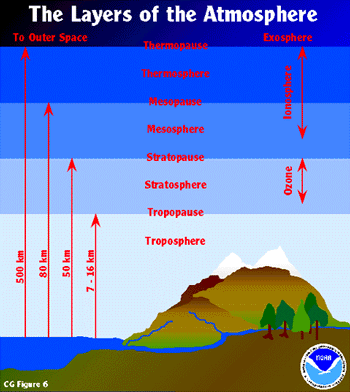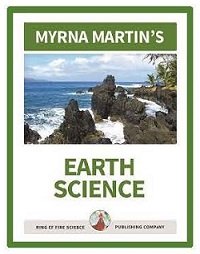Earths Atmosphere Layers
Introduction
The Earths atmosphere layers are similar to the layers in the interior of the Earth. There are four major layers of atmosphere above the Earth that are separated by temperature. Each layer of the layers are separated by an increasing or decreasing temperature of the gases in the layer. The tropopause, stratopause, mesopause are areas where two atmosphere layers gradually transition from one layer into another layer.

Major Layers of the Earth's Atmosphere
Atmosphere gases
The concentration of atmosphere gases varies depending on the atmosphere layers. The troposphere contains primarily nitrogen (78%) and oxygen (21%). The remaining 1% of the atmosphere is trace gases. The stratosphere contains a layer of relatively high concentrations of ozone.
The lower part of the thermosphere is the ionosphere. This layer has free ions and electrons that are the result of ionization of gas molecules. As the distance increases from Earth the atmosphere becomes thinner as the molecules move further and further apart.


Click for More Information and to Order
Earths Atmosphere Layers
Troposphere
Lower boundary is the surface of the Earth. The upper boundary varies between 7 km (23,000 ft.) above the poles and 14 km (56,000 ft.) above the equator. This is the layer of the atmosphere where we live. The troposphere contains 75% of the total mass of the atmosphere. The air cools 6.5°C for each kilometer above sea level.
Most of the energy from the sun travels through the atmosphere and is absorbed by the ground. The ground heats up warming the air above creating air currents. The rising of warm air and falling of cooler air creates convection currents that cause air circulation in this layer of the atmosphere.
Stratosphere 7-17 km to 50 km
The lower boundary is the tropopause which separates the stratosphere from the troposphere. The upper boundary of the stratosphere is 50 km (32 miles; 170,000 feet). The bottom layer of the stratosphere remains constantly at approximately 60°C. Jet streams form here as cold air from the poles meets the warmer air rising from the equator. It is a strong eastward moving wind that blows horizontally around the Earth.
The stratosphere contains the ozone layer. Ozone is created when radiation from the sun splits two-atom oxygen molecules into separate atoms. They combine with other two-atom molecules to form a three-atom molecule. The layer acts as a shield from ultraviolet radiation from the sun. The upper part of the stratosphere warms up to approximately 18°C as the ozone reacts with ultraviolet radiation giving off enough heat to warm this layer.
Mesosphere
The mesosphere is the third layer of the atmosphere. It extends from the top of the stratopause to an altitude between 80 and 85 km. The temperature begins to drop in this layer until it reaches minus 90°C. The upper region of the mesosphere is the coldest region of the Earths atmosphere layers.
Water vapor is sometimes present in this layer and it can be seen from Earth as thin feathery clouds of ice crystals. Many meteors entering the atmosphere burn up in this layer. The heat causes enough friction between a meteoroid and gas particles in the mesosphere to burn them up. Shooting stars are the trail of hot glowing gases as a meteoroid burns.
Thermosphere (Ionosphere and exosphere)
Location of layer above Earth: 640 kilometers (400 miles; 2,100,000 feet)
The thermosphere has two layers of Earths atmosphere layers. The atmosphere is very thin in the thermosphere. The space shuttles orbit in the thermosphere. The layer has free ions and electrons that are the result of ionization of gas particles. Radio waves bounce off the ionosphere allowing communication with countries overseas. The aurora borealis, (northern lights) form when electrically charged particles from the sun collide with particles in the ionosphere producing multicolored lights. The temperature in this region can reach 1500°C (2,730 degrees F). The air particles are so far apart that a person would not feel warm because of the low density of the particles.
The exosphere is the highest layer of the atmosphere. It extends up to 10,000 km (6,200 miles; 33,000,000 ft.) above the Earth. Satellites orbit the Earth in the exosphere. The atmosphere in this layer is extremely thin and atoms and molecules of air are constantly escaping into outer space. Free-moving particles move in and out of the solar wind in the exosphere.
More Weather Links
Weather Facts: The weather affects our everyday lives throughout the year. Use the links on this page to learn about hurricanes, the Earths atmosphere layers, air pressure, lightning and thunderstorms.
Formation of hurricanes in North Pacific Ocean occurs in two basins. They are the two most active basins for cyclones to form on our planet. Meteorologist recognized the north eastern Pacific Ocean basin 1920s.
The Earths atmosphere layers are similar to the interior of the Earth. Find out about the four major layers of atmosphere that are separated by temperature.
What is air pressure? It is the weight of air molecules pressing down on the Earth. The pressure changes as you move upward into the atmosphere.
What causes lightning and what are the warning signs before lightning strikes? Find out on this fascinating page about lightning.
What are thunderstorm clouds and how do they form? Find out how severe thunderstorms produce rain, lightning, hail and occasionally tornadoes.
KIDS FUN Science Bookstore
Check out Myrna Martin's award winning textbooks, e-books, videos and rock sets. The Kids Fun Science Bookstore covers a wide range of earth science topics. Click here to browse.










